ELK实时日志分析平台环境部署
来源:互联网 发布:世界地图历史演变软件 编辑:程序博客网 时间:2024/04/29 15:43
原文地址:http://www.cnblogs.com/kevingrace/p/5919021.html
一、概念介绍
日志主要包括系统日志、应用程序日志和安全日志。系统运维和开发人员可以通过日志了解服务器软硬件信息、检查配置过程中的错误及错误发生的原因。经常分析日志可以了解服务器的负荷,性能安全性,从而及时采取措施纠正错误。
通常,日志被分散的储存不同的设备上。如果你管理数十上百台服务器,你还在使用依次登录每台机器的传统方法查阅日志。这样是不是感觉很繁琐和效率低下。当务之急我们使用集中化的日志管理,例如:开源的syslog,将所有服务器上的日志收集汇总。
集中化管理日志后,日志的统计和检索又成为一件比较麻烦的事情,一般我们使用grep、awk和wc等Linux命令能实现检索和统计,但是对于要求更高的查询、排序和统计等要求和庞大的机器数量依然使用这样的方法难免有点力不从心。
开源实时日志分析ELK平台能够完美的解决我们上述的问题,ELK由ElasticSearch、Logstash和Kiabana三个开源工具组成:
1)ElasticSearch是一个基于Lucene的开源分布式搜索服务器。它的特点有:分布式,零配置,自动发现,索引自动分片,索引副本机制,restful风格接口,多数据源,自动搜索负载等。它提供了一个分布式多用户能力的全文搜索引擎,基于RESTful web接口。Elasticsearch是用Java开发的,并作为Apache许可条款下的开放源码发布,是第二流行的企业搜索引擎。设计用于云计算中,能够达到实时搜索,稳定,可靠,快速,安装使用方便。
在elasticsearch中,所有节点的数据是均等的。
2)Logstash是一个完全开源的工具,他可以对你的日志进行收集、过滤、分析,并将其存储供以后使用(如,搜索),您可以使用它。说到搜索,logstash带有一个web界面,搜索和展示所有日志。
3)Kibana 是一个基于浏览器页面的Elasticsearch前端展示工具,也是一个开源和免费的工具,它Kibana可以为 Logstash 和 ElasticSearch 提供的日志分析友好的 Web 界面,可以帮助您汇总、分析和搜索重要数据日志。
ELK工作原理展示图:

如上图:Logstash收集AppServer产生的Log,并存放到ElasticSearch集群中,而Kibana则从ES集群中查询数据生成图表,再返回给Browser。
二、ELK环境部署
(0)基础环境介绍
系统: Centos7.1
防火墙: 关闭
Sellinux: 关闭
机器环境: 两台
elk-node1: 192.168.1.160 #master机器
elk-node2:192.168.1.161 #slave机器
注明:
master-slave模式:
master收集到日志后,会把一部分数据碎片到salve上(随机的一部分数据);同时,master和slave又都会各自做副本,并把副本放到对方机器上,这样就保证了数据不会丢失。
如果master宕机了,那么客户端在日志采集配置中将elasticsearch主机指向改为slave,就可以保证ELK日志的正常采集和web展示。
=========================================================================================
由于elk-node1和elk-node2两台是虚拟机,没有外网ip,所以访问需要通过宿主机进行代理转发实现。
有以下两种转发设置:(任选其一)
通过访问宿主机的19200,19201端口分别转发到elk-node1,elk-node2的9200端口
通过访问宿主机的15601端口转发到elk-node1的5601端口
宿主机:112.110.115.10(内网ip为192.168.1.7) (为了不让线上的真实ip暴露,这里任意给了一个ip做记录)
a)通过宿主机的haproxy服务进行代理转发,如下是宿主机上的代理配置:
[root@kvm-server conf]# pwd
/usr/local/haproxy/conf
[root@kvm-server conf]# cat haproxy.cfg
..........
..........
listen node1-9200 0.0.0.0:19200
mode tcp
option tcplog
balance roundrobin
server 192.168.1.160 192.168.1.160:9200 weight 1 check inter 1s rise 2 fall 2
listen node2-9200 0.0.0.0:19201
mode tcp
option tcplog
balance roundrobin
server 192.168.1.161 192.168.1.161:9200 weight 1 check inter 1s rise 2 fall 2
listen node1-5601 0.0.0.0:15601
mode tcp
option tcplog
balance roundrobin
server 192.168.1.160 192.168.1.160:5601 weight 1 check inter 1s rise 2 fall 2
重启haproxy服务
[root@kvm-server conf]# /etc/init.d/haproxy restart
设置宿主机防火墙
[root@kvm-server conf]# cat /etc/sysconfig/iptables
.........
-A INPUT -p tcp -m state --state NEW -m tcp --dport 19200 -j ACCEPT
-A INPUT -p tcp -m state --state NEW -m tcp --dport 19201 -j ACCEPT
-A INPUT -p tcp -m state --state NEW -m tcp --dport 15601 -j ACCEPT
[root@kvm-server conf]# /etc/init.d/iptables restart
b)通过宿主机的NAT端口转发实现
[root@kvm-server conf]# iptables -t nat -A PREROUTING -p tcp -m tcp --dport 19200 -j DNAT --to-destination 192.168.1.160:9200
[root@kvm-server conf]# iptables -t nat -A POSTROUTING -d 192.168.1.160/32 -p tcp -m tcp --sport 9200 -j SNAT --to-source 192.168.1.7
[root@kvm-server conf]# iptables -t filter -A INPUT -p tcp -m state --state NEW -m tcp --dport 19200 -j ACCEPT
[root@kvm-server conf]# iptables -t nat -A PREROUTING -p tcp -m tcp --dport 19201 -j DNAT --to-destination 192.168.1.161:9200
[root@kvm-server conf]# iptables -t nat -A POSTROUTING -d 192.168.1.161/32 -p tcp -m tcp --sport 9200 -j SNAT --to-source 192.168.1.7
[root@kvm-server conf]# iptables -t filter -A INPUT -p tcp -m state --state NEW -m tcp --dport 19201 -j ACCEPT
[root@kvm-server conf]# iptables -t nat -A PREROUTING -p tcp -m tcp --dport 15601 -j DNAT --to-destination 192.168.1.160:5601
[root@kvm-server conf]# iptables -t nat -A POSTROUTING -d 192.168.1.160/32 -p tcp -m tcp --sport 5601 -j SNAT --to-source 192.168.1.7
[root@kvm-server conf]# iptables -t filter -A INPUT -p tcp -m state --state NEW -m tcp --dport 15601 -j ACCEPT
[root@kvm-server conf]# service iptables save
[root@kvm-server conf]# service iptables restart
提醒一点:
nat端口转发设置成功后,/etc/sysconfig/iptables文件里要注释掉下面两行!不然nat转发会有问题!一般如上面在nat转发规则设置好并save和restart防火墙之后就会自动在/etc/sysconfig/iptables文件里删除掉下面两行内容了。
[root@kvm-server conf]# vim /etc/sysconfig/iptables
..........
#-A INPUT -j REJECT --reject-with icmp-host-prohibited
#-A FORWARD -j REJECT --reject-with icmp-host-prohibited
[root@linux-node1 ~]# service iptables restart
=========================================================================================
(1)Elasticsearch安装配置
基础环境安装(elk-node1和elk-node2同时操作)
1)下载并安装GPG Key
[root@elk-node1 ~]# rpm --import https://packages.elastic.co/GPG-KEY-elasticsearch
2)添加yum仓库
[root@elk-node1 ~]# vim /etc/yum.repos.d/elasticsearch.repo
[elasticsearch-2.x]
name=Elasticsearch repository for 2.x packages
baseurl=http://packages.elastic.co/elasticsearch/2.x/centos
gpgcheck=1
gpgkey=http://packages.elastic.co/GPG-KEY-elasticsearch
enabled=1
3)安装elasticsearch
[root@elk-node1 ~]# yum install -y elasticsearch
4)安装相关测试软件
#提前先下载安装epel源:epel-release-latest-7.noarch.rpm,否则yum会报错:No Package.....
[root@elk-node1 ~]# wget http://dl.fedoraproject.org/pub/epel/epel-release-latest-7.noarch.rpm
[root@elk-node1 ~]# rpm -ivh epel-release-latest-7.noarch.rpm
#安装Redis
[root@elk-node1 ~]# yum install -y redis
#安装Nginx
[root@elk-node1 ~]# yum install -y nginx
#安装java
[root@elk-node1 ~]# yum install -y java
安装完java后,检测
[root@elk-node1 ~]# java -version
openjdk version "1.8.0_102"
OpenJDK Runtime Environment (build 1.8.0_102-b14)
OpenJDK 64-Bit Server VM (build 25.102-b14, mixed mode)
配置部署(下面先进行elk-node1的配置)
1)配置修改配置文件
[root@elk-node1 ~]# mkdir -p /data/es-data
[root@elk-node1 ~]# vim /etc/elasticsearch/elasticsearch.yml 【将里面内容情况,配置下面内容】
cluster.name: huanqiu # 组名(同一个组,组名必须一致)
node.name: elk-node1 # 节点名称,建议和主机名一致
path.data: /data/es-data # 数据存放的路径
path.logs: /var/log/elasticsearch/ # 日志存放的路径
bootstrap.mlockall: true # 锁住内存,不被使用到交换分区去
network.host: 0.0.0.0 # 网络设置
http.port: 9200 # 端口
2)启动并查看
[root@elk-node1 ~]# chown -R elasticsearch.elasticsearch /data/
[root@elk-node1 ~]# systemctl start elasticsearch
[root@elk-node1 ~]# systemctl status elasticsearch
CGroup: /system.slice/elasticsearch.service
└─3005 /bin/java -Xms256m -Xmx1g -Djava.awt.headless=true -XX:+UseParNewGC -XX:+UseConcMarkSweepGC -XX:CMSI...
注意:上面可以看出elasticsearch设置的内存最小256m,最大1g
[root@linux-node1 src]# netstat -antlp |egrep "9200|9300"
tcp6 0 0 :::9200 :::* LISTEN 3005/java
tcp6 0 0 :::9300 :::* LISTEN 3005/java
然后通过web访问(访问的浏览器最好用google浏览器)
http://112.110.115.10:19200/
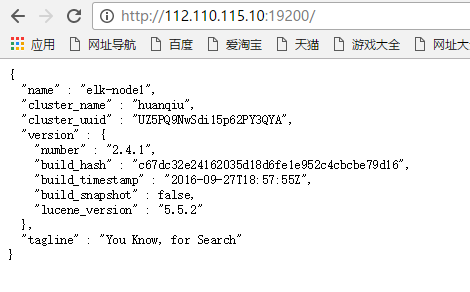
3)通过命令的方式查看数据(在112.110.115.10宿主机或其他外网服务器上查看,如下)
[root@kvm-server src]# curl -i -XGET 'http://192.168.1.160:9200/_count?pretty' -d '{"query":{"match_all":{}}}'
HTTP/1.1 200 OK
Content-Type: application/json; charset=UTF-8
Content-Length: 95
{
"count" : 0,
"_shards" : {
"total" : 0,
"successful" : 0,
"failed" : 0
}
}
这样感觉用命令来查看,特别的不爽。
4)接下来安装插件,使用插件进行查看~ (下面两个插件要在elk-node1和elk-node2上都要安装)
4.1)安装head插件
----------------------------------------------------------------------------------------------------
a)插件安装方法一
[root@elk-node1 src]# /usr/share/elasticsearch/bin/plugin install mobz/elasticsearch-head
b)插件安装方法二
首先下载head插件,下载到/usr/loca/src目录下
下载地址:https://github.com/mobz/elasticsearch-head
----------------------------------------------------------------
head插件包百度云盘下载:https://pan.baidu.com/s/1boBE0qj
提取密码:ifj7
----------------------------------------------------------------
[root@elk-node1 src]# unzip elasticsearch-head-master.zip
[root@elk-node1 src]# ls
elasticsearch-head-master elasticsearch-head-master.zip
在/usr/share/elasticsearch/plugins目录下创建head目录
然后将上面下载的elasticsearch-head-master.zip解压后的文件都移到/usr/share/elasticsearch/plugins/head下
接着重启elasticsearch服务即可!
[root@elk-node1 src]# cd /usr/share/elasticsearch/plugins/
[root@elk-node1 plugins]# mkdir head
[root@elk-node1 plugins]# ls
head
[root@elk-node1 plugins]# cd head
[root@elk-node1 head]# cp -r /usr/local/src/elasticsearch-head-master/* ./
[root@elk-node1 head]# pwd
/usr/share/elasticsearch/plugins/head
[root@elk-node1 head]# chown -R elasticsearch:elasticsearch /usr/share/elasticsearch/plugins
[root@elk-node1 head]# ll
total 40
-rw-r--r--. 1 elasticsearch elasticsearch 104 Sep 28 01:57 elasticsearch-head.sublime-project
-rw-r--r--. 1 elasticsearch elasticsearch 2171 Sep 28 01:57 Gruntfile.js
-rw-r--r--. 1 elasticsearch elasticsearch 3482 Sep 28 01:57 grunt_fileSets.js
-rw-r--r--. 1 elasticsearch elasticsearch 1085 Sep 28 01:57 index.html
-rw-r--r--. 1 elasticsearch elasticsearch 559 Sep 28 01:57 LICENCE
-rw-r--r--. 1 elasticsearch elasticsearch 795 Sep 28 01:57 package.json
-rw-r--r--. 1 elasticsearch elasticsearch 100 Sep 28 01:57 plugin-descriptor.properties
-rw-r--r--. 1 elasticsearch elasticsearch 5211 Sep 28 01:57 README.textile
drwxr-xr-x. 5 elasticsearch elasticsearch 4096 Sep 28 01:57 _site
drwxr-xr-x. 4 elasticsearch elasticsearch 29 Sep 28 01:57 src
drwxr-xr-x. 4 elasticsearch elasticsearch 66 Sep 28 01:57 test
[root@elk-node1 _site]# systemctl restart elasticsearch
-----------------------------------------------------------------------------------------------------
插件访问(最好提前将elk-node2节点的配置和插件都安装后,再来进行访问和数据插入测试)
http://112.110.115.10:19200/_plugin/head/

先插入数据实例,测试下
如下:打开”复合查询“,在POST选项下,任意输入如/index-demo/test,然后在下面输入数据(注意内容之间换行的逗号不要漏掉);
数据输入好之后(如下输入wangshibo;hello world内容),下面点击”验证JSON“->”提交请求“,提交成功后,观察右栏里出现的信息:有index,type,version等信息,failed:0(成功消息)

再查看测试实例,如下:
"复合查询"下,选择GET选项,在/index-demo/test/后面输入上面POST结果中的id号,不输入内容,即{}括号里为空!
然后点击”验证JSON“->"提交请求",观察右栏内就有了上面插入的数据了(即wangshibo,hello world)

打开"基本查询",查看下数据,如下,即可查询到上面插入的数据:

打开“数据浏览”,也能查看到插入的数据:

如下:一定要提前在elk-node2节点上也完成配置(配置内容在下面提到),否则上面插入数据后,集群状态会呈现黄色yellow状态,elk-node2完成配置加入到集群里后就会恢复到正常的绿色状态。

4.2)安装kopf监控插件
--------------------------------------------------------------------------------------------------------------------
a)监控插件安装方法一
[root@elk-node1 src]# /usr/share/elasticsearch/bin/plugin install lmenezes/elasticsearch-kopf
b)监控插件安装方法二
首先下载监控插件kopf,下载到/usr/loca/src目录下
下载地址:https://github.com/lmenezes/elasticsearch-kopf
----------------------------------------------------------------
kopf插件包百度云盘下载:https://pan.baidu.com/s/1qYixSL2
提取密码:ya4t
----------------------------------------------------------------
[root@elk-node1 src]# unzip elasticsearch-kopf-master.zip
[root@elk-node1 src]# ls
elasticsearch-kopf-master elasticsearch-kopf-master.zip
在/usr/share/elasticsearch/plugins目录下创建kopf目录
然后将上面下载的elasticsearch-kopf-master.zip解压后的文件都移到/usr/share/elasticsearch/plugins/kopf下
接着重启elasticsearch服务即可!
[root@elk-node1 src]# cd /usr/share/elasticsearch/plugins/
[root@elk-node1 plugins]# mkdir kopf
[root@elk-node1 plugins]# cd kopf
[root@elk-node1 kopf]# cp -r /usr/local/src/elasticsearch-kopf-master/* ./
[root@elk-node1 kopf]# pwd
/usr/share/elasticsearch/plugins/kopf
[root@elk-node1 kopf]# chown -R elasticsearch:elasticsearch /usr/share/elasticsearch/plugins
[root@elk-node1 kopf]# ll
total 40
-rw-r--r--. 1 elasticsearch elasticsearch 237 Sep 28 16:28 CHANGELOG.md
drwxr-xr-x. 2 elasticsearch elasticsearch 22 Sep 28 16:28 dataset
drwxr-xr-x. 2 elasticsearch elasticsearch 73 Sep 28 16:28 docker
-rw-r--r--. 1 elasticsearch elasticsearch 4315 Sep 28 16:28 Gruntfile.js
drwxr-xr-x. 2 elasticsearch elasticsearch 4096 Sep 28 16:28 imgs
-rw-r--r--. 1 elasticsearch elasticsearch 1083 Sep 28 16:28 LICENSE
-rw-r--r--. 1 elasticsearch elasticsearch 1276 Sep 28 16:28 package.json
-rw-r--r--. 1 elasticsearch elasticsearch 102 Sep 28 16:28 plugin-descriptor.properties
-rw-r--r--. 1 elasticsearch elasticsearch 3165 Sep 28 16:28 README.md
drwxr-xr-x. 6 elasticsearch elasticsearch 4096 Sep 28 16:28 _site
drwxr-xr-x. 4 elasticsearch elasticsearch 27 Sep 28 16:28 src
drwxr-xr-x. 4 elasticsearch elasticsearch 4096 Sep 28 16:28 tests
[root@elk-node1 _site]# systemctl restart elasticsearch
-----------------------------------------------------------------------------------------------------
访问插件:(如下,同样要提前安装好elk-node2节点上的插件,否则访问时会出现集群节点为黄色的yellow告警状态)
http://112.110.115.10:19200/_plugin/kopf/#!/cluster

*************************************************************************
下面进行节点elk-node2的配置 (如上的两个插件也在elk-node2上同样安装)
注释:其实两个的安装配置基本上是一样的。
[root@elk-node2 src]# mkdir -p /data/es-data
[root@elk-node2 ~]# cat /etc/elasticsearch/elasticsearch.yml
cluster.name: huanqiu
node.name: elk-node2
path.data: /data/es-data
path.logs: /var/log/elasticsearch/
bootstrap.mlockall: true
network.host: 0.0.0.0
http.port: 9200
discovery.zen.ping.multicast.enabled: false
discovery.zen.ping.unicast.hosts: ["192.168.1.160", "192.168.1.161"]
# 修改权限配置
[root@elk-node2 src]# chown -R elasticsearch.elasticsearch /data/
# 启动服务
[root@elk-node2 src]# systemctl start elasticsearch
[root@elk-node2 src]# systemctl status elasticsearch
● elasticsearch.service - Elasticsearch
Loaded: loaded (/usr/lib/systemd/system/elasticsearch.service; enabled; vendor preset: disabled)
Active: active (running) since Wed 2016-09-28 16:49:41 CST; 1 weeks 3 days ago
Docs: http://www.elastic.co
Process: 17798 ExecStartPre=/usr/share/elasticsearch/bin/elasticsearch-systemd-pre-exec (code=exited, status=0/SUCCESS)
Main PID: 17800 (java)
CGroup: /system.slice/elasticsearch.service
└─17800 /bin/java -Xms256m -Xmx1g -Djava.awt.headless=true -XX:+UseParNewGC -XX:+UseConcMarkSweepGC -XX:CMSInitiatingOccupancyFra...
Oct 09 13:42:22 elk-node2 elasticsearch[17800]: [2016-10-09 13:42:22,295][WARN ][transport ] [elk-node2] Transport res...943817]
Oct 09 13:42:23 elk-node2 elasticsearch[17800]: [2016-10-09 13:42:23,111][WARN ][transport ] [elk-node2] Transport res...943846]
................
................
# 查看端口
[root@elk-node2 src]# netstat -antlp|egrep "9200|9300"
tcp6 0 0 :::9200 :::* LISTEN 2928/java
tcp6 0 0 :::9300 :::* LISTEN 2928/java
tcp6 0 0 127.0.0.1:48200 127.0.0.1:9300 TIME_WAIT -
tcp6 0 0 ::1:41892 ::1:9300 TIME_WAIT -
*************************************************************************
通过命令的方式查看elk-node2数据(在112.110.115.10宿主机或其他外网服务器上查看,如下)
[root@kvm-server ~]# curl -i -XGET 'http://192.168.1.161:9200/_count?pretty' -d '{"query":{"match_all":{}}}'
HTTP/1.1 200 OK
Content-Type: application/json; charset=UTF-8
Content-Length: 95
{
"count" : 1,
"_shards" : {
"total" : 5,
"successful" : 5,
"failed" : 0
}
然后通过web访问elk-node2
http://112.110.115.10:19201/

访问两个插件:
http://112.110.115.10:19201/_plugin/head/
http://112.110.115.10:19201/_plugin/kopf/#!/cluster
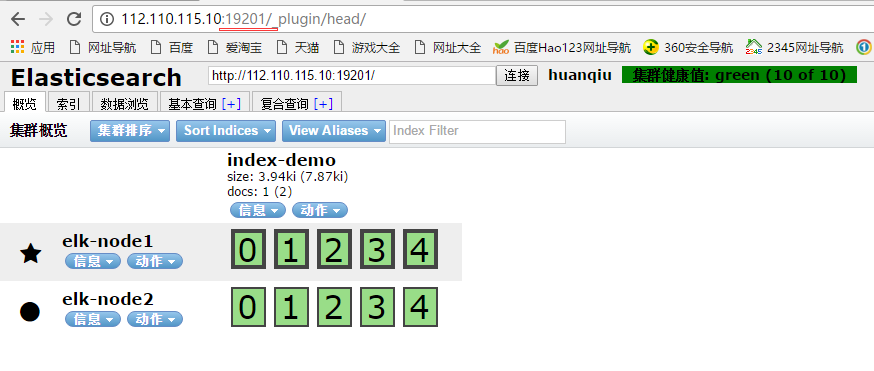
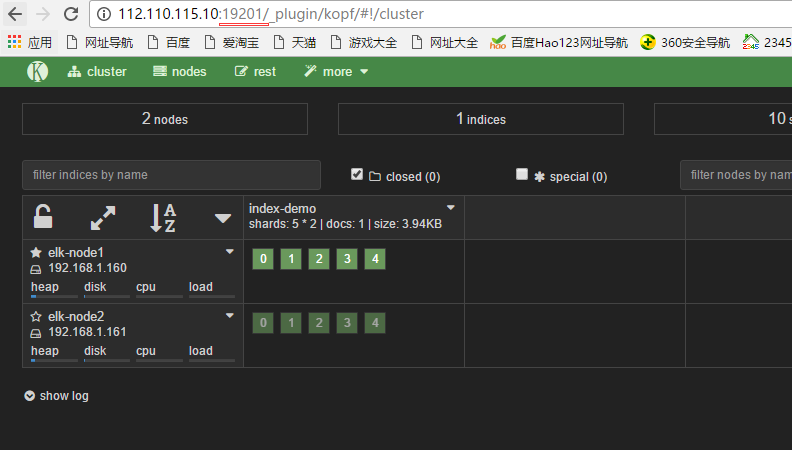
(2)Logstash安装配置(这个在客户机上是要安装的。elk-node1和elk-node2都安装)
基础环境安装(客户端安装logstash,收集到的数据写入到elasticsearch里,就可以登陆logstash界面查看到了)
1)下载并安装GPG Key
[root@elk-node1 ~]# rpm --import https://packages.elastic.co/GPG-KEY-elasticsearch
2)添加yum仓库
[root@hadoop-node1 ~]# vim /etc/yum.repos.d/logstash.repo
[logstash-2.1]
name=Logstash repository for 2.1.x packages
baseurl=http://packages.elastic.co/logstash/2.1/centos
gpgcheck=1
gpgkey=http://packages.elastic.co/GPG-KEY-elasticsearch
enabled=1
3)安装logstash
[root@elk-node1 ~]# yum install -y logstash
4)logstash启动
[root@elk-node1 ~]# systemctl start elasticsearch
[root@elk-node1 ~]# systemctl status elasticsearch
● elasticsearch.service - Elasticsearch
Loaded: loaded (/usr/lib/systemd/system/elasticsearch.service; disabled; vendor preset: disabled)
Active: active (running) since Mon 2016-11-07 18:33:28 CST; 3 days ago
Docs: http://www.elastic.co
Main PID: 8275 (java)
CGroup: /system.slice/elasticsearch.service
└─8275 /bin/java -Xms256m -Xmx1g -Djava.awt.headless=true -XX:+UseParNewGC -XX:+UseConcMarkSweepGC -XX:CMSInitiatingOccupancyFrac...
..........
..........
数据的测试
1)基本的输入输出
[root@elk-node1 ~]# /opt/logstash/bin/logstash -e 'input { stdin{} } output { stdout{} }'
Settings: Default filter workers: 1
Logstash startup completed
hello #输入这个
2016-11-11T06:41:07.690Z elk-node1 hello #输出这个
wangshibo #输入这个
2016-11-11T06:41:10.608Z elk-node1 wangshibo #输出这个
2)使用rubydebug详细输出
[root@elk-node1 ~]# /opt/logstash/bin/logstash -e 'input { stdin{} } output { stdout{ codec => rubydebug} }'
Settings: Default filter workers: 1
Logstash startup completed
hello #输入这个
{ #输出下面信息
"message" => "hello",
"@version" => "1",
"@timestamp" => "2016-11-11T06:44:06.711Z",
"host" => "elk-node1"
}
wangshibo #输入这个
{ #输出下面信息
"message" => "wangshibo",
"@version" => "1",
"@timestamp" => "2016-11-11T06:44:11.270Z",
"host" => "elk-node1"
}
3) 把内容写到elasticsearch中
[root@elk-node1 ~]# /opt/logstash/bin/logstash -e 'input { stdin{} } output { elasticsearch { hosts => ["192.168.1.160:9200"]} }'
Settings: Default filter workers: 1
Logstash startup completed #输入下面的测试数据
123456
wangshibo
huanqiu
hahaha
使用rubydebug和写到elasticsearch中的区别:其实就在于后面标准输出的区别,前者使用codec;后者使用elasticsearch
写到elasticsearch中在logstash中查看,如下图:
注意:
master收集到日志后,会把一部分数据碎片到salve上(随机的一部分数据),master和slave又都会各自做副本,并把副本放到对方机器上,这样就保证了数据不会丢失。
如下,master收集到的数据放到了自己的第1,3分片上,其他的放到了slave的第0,2,4分片上。



4)即写到elasticsearch中又写在文件中一份
[root@elk-node1 ~]# /opt/logstash/bin/logstash -e 'input { stdin{} } output { elasticsearch { hosts => ["192.168.1.160:9200"]} stdout{ codec => rubydebug}}'
Settings: Default filter workers: 1
Logstash startup completed
huanqiupc
{
"message" => "huanqiupc",
"@version" => "1",
"@timestamp" => "2016-11-11T07:27:42.012Z",
"host" => "elk-node1"
}
wangshiboqun
{
"message" => "wangshiboqun",
"@version" => "1",
"@timestamp" => "2016-11-11T07:27:55.396Z",
"host" => "elk-node1"
}
以上文本可以长期保留、操作简单、压缩比大。下面登陆elasticsearch界面中查看;

logstash的配置和文件的编写
1)logstash的配置
简单的配置方式:
[root@elk-node1 ~]# vim /etc/logstash/conf.d/01-logstash.conf
input { stdin { } }
output {
elasticsearch { hosts => ["192.168.1.160:9200"]}
stdout { codec => rubydebug }
}
它的执行:
[root@elk-node1 ~]# /opt/logstash/bin/logstash -f /etc/logstash/conf.d/01-logstash.conf
Settings: Default filter workers: 1
Logstash startup completed
beijing #输入内容
{ #输出下面信息
"message" => "beijing",
"@version" => "1",
"@timestamp" => "2016-11-11T07:41:48.401Z",
"host" => "elk-node1"
}
--------------------------------------------------------------------------------------------------
参考内容:
https://www.elastic.co/guide/en/logstash/current/configuration.html
https://www.elastic.co/guide/en/logstash/current/configuration-file-structure.html
--------------------------------------------------------------------------------------------------

2)收集系统日志
[root@elk-node1 ~]# vim file.confinput { file { path => "/var/log/messages" type => "system" start_position => "beginning" }}output { elasticsearch { hosts => ["192.168.1.160:9200"] index => "system-%{+YYYY.MM.dd}" }}
执行上面日志信息的收集,如下,这个命令会一直在执行中,表示日志在监控收集中;如果中断,就表示日志不在收集!所以需要放在后台执行~
[root@elk-node1 ~]# /opt/logstash/bin/logstash -f file.conf &
登陆elasticsearch界面,查看本机系统日志的信息:
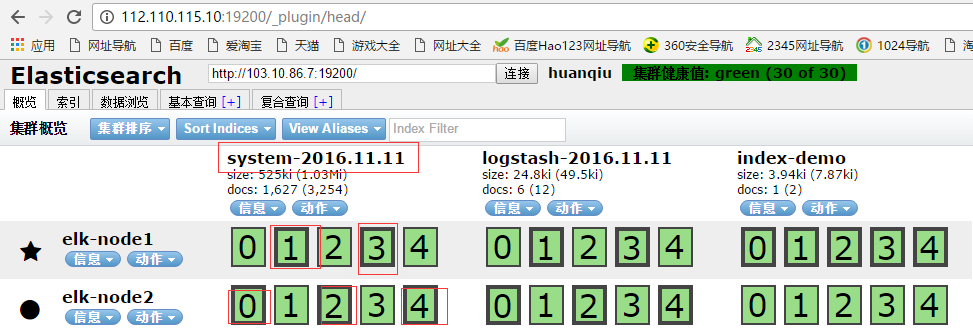


--------------------------------------------------------------------------------------------------
参考内容:
https://www.elastic.co/guide/en/logstash/current/plugins-outputs-elasticsearch.html
--------------------------------------------------------------------------------------------------
3)收集java日志,其中包含上面讲到的日志收集
[root@elk-node1 ~]# vim file.confinput { file { path => "/var/log/messages" type => "system" start_position => "beginning" }}input { file { path => "/var/log/elasticsearch/huanqiu.log" type => "es-error" start_position => "beginning" }}output { if [type] == "system"{ elasticsearch { hosts => ["192.168.1.160:9200"] index => "system-%{+YYYY.MM.dd}" } } if [type] == "es-error"{ elasticsearch { hosts => ["192.168.1.160:9200"] index => "es-error-%{+YYYY.MM.dd}" } }}注意:
如果你的日志中有type字段 那你就不能在conf文件中使用type
执行如下命令收集:
[root@elk-node1 ~]# /opt/logstash/bin/logstash -f file.conf &
登陆elasticsearch界面,查看数据:


--------------------------------------------------------------------------------------------------
参考内容:
https://www.elastic.co/guide/en/logstash/current/event-dependent-configuration.html
--------------------------------------------------------------------------------------------------
---------------
有个问题:
每个报错都给收集成一行了,不是按照一个报错,一个事件模块收集的。
下面将行换成事件的方式展示:
[root@elk-node1 ~]# vim multiline.confinput { stdin { codec => multiline { pattern => "^\[" negate => true what => "previous" } }}output { stdout { codec => "rubydebug" } }执行命令:
[root@elk-node1 ~]# /opt/logstash/bin/logstash -f multiline.confSettings: Default filter workers: 1Logstash startup completed123456[123{ "@timestamp" => "2016-11-11T09:28:56.824Z", "message" => "123\n456", "@version" => "1", "tags" => [ [0] "multiline" ], "host" => "elk-node1"}123][456]{ "@timestamp" => "2016-11-11T09:29:09.043Z", "message" => "[123\n123]", "@version" => "1", "tags" => [ [0] "multiline" ], "host" => "elk-node1"}在没有遇到[的时候,系统不会收集,只有遇见[的时候,才算是一个事件,才收集起来。
--------------------------------------------------------------------------------------------------
参考内容
https://www.elastic.co/guide/en/logstash/current/plugins-codecs-multiline.html
--------------------------------------------------------------------------------------------------
(3)Kibana安装配置
1)kibana的安装:
[root@elk-node1 ~]# cd /usr/local/src
[root@elk-node1 src]# wget https://download.elastic.co/kibana/kibana/kibana-4.3.1-linux-x64.tar.gz
[root@elk-node1 src]# tar zxf kibana-4.3.1-linux-x64.tar.gz
[root@elk-node1 src]# mv kibana-4.3.1-linux-x64 /usr/local/
[root@elk-node1 src]# ln -s /usr/local/kibana-4.3.1-linux-x64/ /usr/local/kibana
2)修改配置文件:
[root@elk-node1 config]# pwd
/usr/local/kibana/config
[root@elk-node1 config]# cp kibana.yml kibana.yml.bak
[root@elk-node1 config]# vim kibana.yml
server.port: 5601
server.host: "0.0.0.0"
elasticsearch.url: "http://192.168.1.160:9200"
kibana.index: ".kibana"
因为他一直运行在前台,要么选择开一个窗口,要么选择使用screen。
安装并使用screen启动kibana:
[root@elk-node1 ~]# yum -y install screen
[root@elk-node1 ~]# screen #这样就另开启了一个终端窗口
[root@elk-node1 ~]# /usr/local/kibana/bin/kibana
log [18:23:19.867] [info][status][plugin:kibana] Status changed from uninitialized to green - Ready
log [18:23:19.911] [info][status][plugin:elasticsearch] Status changed from uninitialized to yellow - Waiting for Elasticsearch
log [18:23:19.941] [info][status][plugin:kbn_vislib_vis_types] Status changed from uninitialized to green - Ready
log [18:23:19.953] [info][status][plugin:markdown_vis] Status changed from uninitialized to green - Ready
log [18:23:19.963] [info][status][plugin:metric_vis] Status changed from uninitialized to green - Ready
log [18:23:19.995] [info][status][plugin:spyModes] Status changed from uninitialized to green - Ready
log [18:23:20.004] [info][status][plugin:statusPage] Status changed from uninitialized to green - Ready
log [18:23:20.010] [info][status][plugin:table_vis] Status changed from uninitialized to green - Ready
然后按ctrl+a+d组合键,这样在上面另启的screen屏里启动的kibana服务就一直运行在前台了....
[root@elk-node1 ~]# screen -ls
There is a screen on:
15041.pts-0.elk-node1 (Detached)
1 Socket in /var/run/screen/S-root.
(3)访问kibana:http://112.110.115.10:15601/
如下,如果是添加上面设置的java日志收集信息,则在下面填写es-error*;如果是添加上面设置的系统日志信息system*,以此类型(可以从logstash界面看到日志收集项)

然后点击上面的Discover,在Discover中查看:

查看日志登陆,需要点击“Discover”-->"message",点击它后面的“add”
注意:
需要右边查看日志内容时带什么属性,就在左边点击相应属性后面的“add”
如下图,添加了message和path的属性:

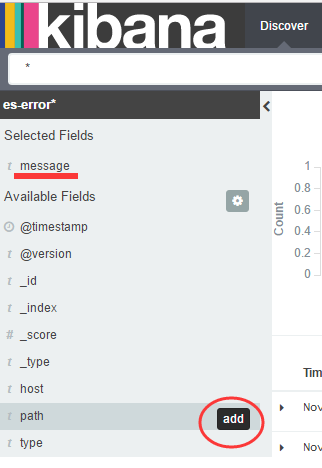
这样,右边显示的日志内容的属性就带了message和path

点击右边日志内容属性后面隐藏的<<,就可将内容向前缩进


添加新的日志采集项,点击Settings->+Add New,比如添加system系统日志。注意后面的*不要忘了。

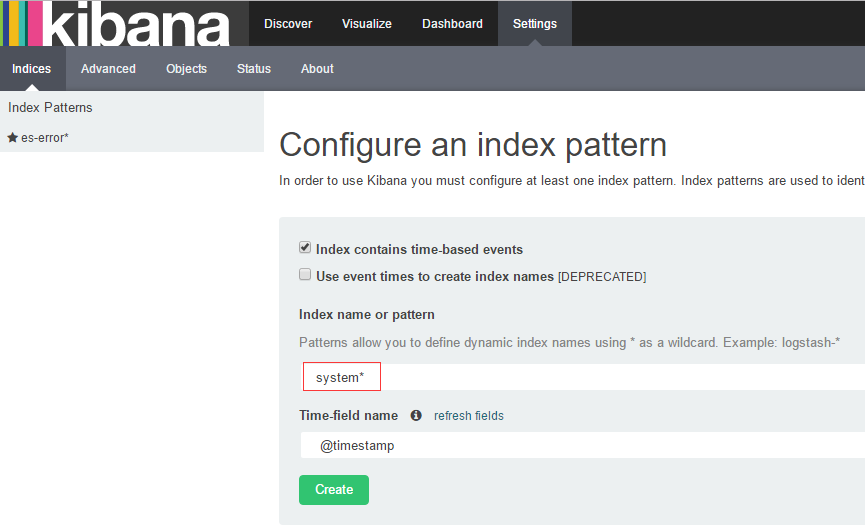



删除kibana里的日志采集项,如下,点击删除图标即可。

如果打开kibana查看日志,发现没有日志内容,出现“No results found”,如下图所示,这说明要查看的日志在当前时间没有日志信息输出,可以点击右上角的时间钟来调试日志信息的查看。




4)收集nginx的访问日志
修改nginx的配置文件,分别在nginx.conf的http和server配置区域添加下面内容:
##### http 标签中
log_format json '{"@timestamp":"$time_iso8601",'
'"@version":"1",'
'"client":"$remote_addr",'
'"url":"$uri",'
'"status":"$status",'
'"domain":"$host",'
'"host":"$server_addr",'
'"size":$body_bytes_sent,'
'"responsetime":$request_time,'
'"referer": "$http_referer",'
'"ua": "$http_user_agent"'
'}';
##### server标签中
access_log /var/log/nginx/access_json.log json;
截图如下:


启动nginx服务:
[root@elk-node1 ~]# systemctl start nginx[root@elk-node1 ~]# systemctl status nginx● nginx.service - The nginx HTTP and reverse proxy server Loaded: loaded (/usr/lib/systemd/system/nginx.service; disabled; vendor preset: disabled) Active: active (running) since Fri 2016-11-11 19:06:55 CST; 3s ago Process: 15119 ExecStart=/usr/sbin/nginx (code=exited, status=0/SUCCESS) Process: 15116 ExecStartPre=/usr/sbin/nginx -t (code=exited, status=0/SUCCESS) Process: 15114 ExecStartPre=/usr/bin/rm -f /run/nginx.pid (code=exited, status=0/SUCCESS) Main PID: 15122 (nginx) CGroup: /system.slice/nginx.service ├─15122 nginx: master process /usr/sbin/nginx ├─15123 nginx: worker process └─15124 nginx: worker processNov 11 19:06:54 elk-node1 systemd[1]: Starting The nginx HTTP and reverse proxy server...Nov 11 19:06:55 elk-node1 nginx[15116]: nginx: the configuration file /etc/nginx/nginx.conf syntax is okNov 11 19:06:55 elk-node1 nginx[15116]: nginx: configuration file /etc/nginx/nginx.conf test is successfulNov 11 19:06:55 elk-node1 systemd[1]: Started The nginx HTTP and reverse proxy server.编写收集文件
这次使用json的方式收集:
[root@elk-node1 ~]# vim json.confinput { file { path => "/var/log/nginx/access_json.log" codec => "json" }}output { stdout { codec => "rubydebug" }}启动日志收集程序:
[root@elk-node1 ~]# /opt/logstash/bin/logstash -f json.conf #或加个&放在后台执行
访问nginx页面(在elk-node1的宿主机上执行访问页面的命令:curl http://192.168.1.160)就会出现以下内容:
[root@elk-node1 ~]# /opt/logstash/bin/logstash -f json.confSettings: Default filter workers: 1Logstash startup completed{ "@timestamp" => "2016-11-11T11:10:53.000Z", "@version" => "1", "client" => "192.168.1.7", "url" => "/index.html", "status" => "200", "domain" => "192.168.1.160", "host" => "192.168.1.160", "size" => 3700, "responsetime" => 0.0, "referer" => "-", "ua" => "curl/7.19.7 (x86_64-redhat-linux-gnu) libcurl/7.19.7 NSS/3.14.0.0 zlib/1.2.3 libidn/1.18 libssh2/1.4.2", "path" => "/var/log/nginx/access_json.log"}注意:
上面的json.conf配置只是将nginx日志输出,还没有输入到elasticsearch里,所以这个时候在elasticsearch界面里是采集不到nginx日志的。
需要配置一下,将nginx日志输入到elasticsearch中,将其汇总到总文件file.conf里,如下也将nginx-log日志输入到elasticserach里:(后续就可以只用这个汇总文件,把要追加的日志汇总到这个总文件里即可)
[root@elk-node1 ~]# cat file.confinput { file { path => "/var/log/messages" type => "system" start_position => "beginning" } file { path => "/var/log/elasticsearch/huanqiu.log" type => "es-error" start_position => "beginning" codec => multiline { pattern => "^\[" negate => true what => "previous" } } file { path => "/var/log/nginx/access_json.log" codec => json start_position => "beginning" type => "nginx-log" }}output { if [type] == "system"{ elasticsearch { hosts => ["192.168.1.160:9200"] index => "system-%{+YYYY.MM.dd}" } } if [type] == "es-error"{ elasticsearch { hosts => ["192.168.1.160:9200"] index => "es-error-%{+YYYY.MM.dd}" } } if [type] == "nginx-log"{ elasticsearch { hosts => ["192.168.1.160:9200"] index => "nignx-log-%{+YYYY.MM.dd}" } }}
可以加上--configtest参数,测试下配置文件是否有语法错误或配置不当的地方,这个很重要!!
[root@elk-node1 ~]# /opt/logstash/bin/logstash -f file.conf --configtest
Configuration OK
然后接着执行logstash命令(由于上面已经将这个执行命令放到了后台,所以这里其实不用执行,也可以先kill之前的,再放后台执行),然后可以再访问nginx界面测试下
[root@elk-node1 ~]# /opt/logstash/bin/logstash -f file.conf &
登陆elasticsearch界面查看:

将nginx日志整合到kibana界面里,如下:
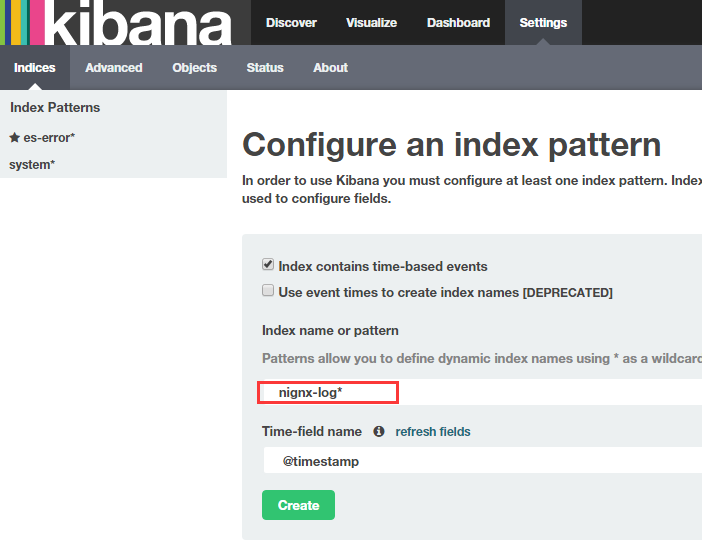

5)收集系统日志
编写收集文件并执行。
[root@elk-node1 ~]# cat syslog.confinput { syslog { type => "system-syslog" host => "192.168.1.160" port => "514" }}output { stdout { codec => "rubydebug" }}对上面的采集文件进行执行:
[root@elk-node1 ~]# /opt/logstash/bin/logstash -f syslog.conf
重新开启一个窗口,查看服务是否启动:
[root@elk-node1 ~]# netstat -ntlp|grep 514
tcp6 0 0 192.168.1.160:514 :::* LISTEN 17842/java
[root@elk-node1 ~]# vim /etc/rsyslog.conf
#*.* @@remote-host:514 【在此行下面添加如下内容】
*.* @@192.168.1.160:514
[root@elk-node1 ~]# systemctl restart rsyslog
回到原来的窗口(即上面采集文件的执行终端),就会出现数据:
[root@elk-node1 ~]# /opt/logstash/bin/logstash -f syslog.confSettings: Default filter workers: 1Logstash startup completed{ "message" => "Stopping System Logging Service...\n", "@version" => "1", "@timestamp" => "2016-11-13T10:35:30.000Z", "type" => "system-syslog", "host" => "192.168.1.160", "priority" => 30, "timestamp" => "Nov 13 18:35:30", "logsource" => "elk-node1", "program" => "systemd", "severity" => 6, "facility" => 3, "facility_label" => "system", "severity_label" => "Informational"}................再次添加到总文件file.conf中:
[root@elk-node1 ~]# cat file.confinput { file { path => "/var/log/messages" type => "system" start_position => "beginning" } file { path => "/var/log/elasticsearch/huanqiu.log" type => "es-error" start_position => "beginning" codec => multiline { pattern => "^\[" negate => true what => "previous" } } file { path => "/var/log/nginx/access_json.log" codec => json start_position => "beginning" type => "nginx-log" } syslog { type => "system-syslog" host => "192.168.1.160" port => "514" }}output { if [type] == "system"{ elasticsearch { hosts => ["192.168.1.160:9200"] index => "system-%{+YYYY.MM.dd}" } } if [type] == "es-error"{ elasticsearch { hosts => ["192.168.1.160:9200"] index => "es-error-%{+YYYY.MM.dd}" } } if [type] == "nginx-log"{ elasticsearch { hosts => ["192.168.1.160:9200"] index => "nignx-log-%{+YYYY.MM.dd}" } } if [type] == "system-syslog"{ elasticsearch { hosts => ["192.168.1.160:9200"] index => "system-syslog-%{+YYYY.MM.dd}" } }}执行总文件(先测试下总文件配置是否有误,然后先kill之前在后台启动的file.conf文件,再次执行):
[root@elk-node1 ~]# /opt/logstash/bin/logstash -f file.conf --configtest
Configuration OK
[root@elk-node1 ~]# /opt/logstash/bin/logstash -f file.conf &
测试:
向日志中添加数据,看elasticsearch和kibana的变化:
[root@elk-node1 ~]# logger "hehehehehehe1"
[root@elk-node1 ~]# logger "hehehehehehe2"
[root@elk-node1 ~]# logger "hehehehehehe3"
[root@elk-node1 ~]# logger "hehehehehehe4"
[root@elk-node1 ~]# logger "hehehehehehe5"

添加到kibana界面中:


6)TCP日志的收集
编写日志收集文件,并执行:(有需要的话,可以将下面收集文件的配置汇总到上面的总文件file.conf里,进而输入到elasticsearch界面里和kibana里查看)
[root@elk-node1 ~]# cat tcp.conf
input {
tcp {
host => "192.168.1.160"
port => "6666"
}
}
output {
stdout {
codec => "rubydebug"
}
}
[root@elk-node1 ~]# /opt/logstash/bin/logstash -f tcp.conf
开启另外一个窗口,测试一(安装nc命令:yum install -y nc):
[root@elk-node1 ~]# nc 192.168.1.160 6666 </etc/resolv.conf
回到原来的窗口(即上面采集文件的执行终端),就会出现数据:
[root@elk-node1 ~]# /opt/logstash/bin/logstash -f tcp.conf
Settings: Default filter workers: 1
Logstash startup completed
{
"message" => "",
"@version" => "1",
"@timestamp" => "2016-11-13T11:01:15.280Z",
"host" => "192.168.1.160",
"port" => 49743
}
测试二:
[root@elk-node1 ~]# echo "hehe" | nc 192.168.1.160 6666
[root@elk-node1 ~]# echo "hehe" > /dev/tcp/192.168.1.160/6666
回到之前的执行端口,在去查看,就会显示出来:
[root@elk-node1 ~]# /opt/logstash/bin/logstash -f tcp.confSettings: Default filter workers: 1Logstash startup completed<br>.......{ "message" => "hehe", "@version" => "1", "@timestamp" => "2016-11-13T11:39:58.263Z", "host" => "192.168.1.160", "port" => 53432}{ "message" => "hehe", "@version" => "1", "@timestamp" => "2016-11-13T11:40:13.458Z", "host" => "192.168.1.160", "port" => 53457}7)使用filter
编写文件:
[root@elk-node1 ~]# cat grok.confinput { stdin{}}filter { grok { match => { "message" => "%{IP:client} %{WORD:method} %{URIPATHPARAM:request} %{NUMBER:bytes} %{NUMBER:duration}" } }}output { stdout{ codec => "rubydebug" }}执行检测:
[root@elk-node1 ~]# /opt/logstash/bin/logstash -f grok.confSettings: Default filter workers: 1Logstash startup completed55.3.244.1 GET /index.html 15824 0.043 #输入这个,下面就会自动形成字典的形式{ "message" => "55.3.244.1 GET /index.html 15824 0.043", "@version" => "1", "@timestamp" => "2016-11-13T11:45:47.882Z", "host" => "elk-node1", "client" => "55.3.244.1", "method" => "GET", "request" => "/index.html", "bytes" => "15824", "duration" => "0.043"}其实上面使用的那些变量在程序中都有定义:
[root@elk-node1 ~]# cd /opt/logstash/vendor/bundle/jruby/1.9/gems/logstash-patterns-core-2.0.2/patterns/[root@elk-node1 patterns]# lsaws bro firewalls haproxy junos mcollective mongodb postgresql redisbacula exim grok-patterns java linux-syslog mcollective-patterns nagios rails ruby[root@elk-node1 patterns]# cat grok-patternsfilter { # drop sleep events grok { match => { "message" =>"SELECT SLEEP" } add_tag => [ "sleep_drop" ] tag_on_failure => [] # prevent default _grokparsefailure tag on real records } if "sleep_drop" in [tags] { drop {} } grok { match => [ "message", "(?m)^# User@Host: %{USER:user}\[[^\]]+\] @ (?:(?<clienthost>\S*) )?\[(?:%{IP:clientip})?\]\s+Id: %{NUMBER:row_id:int}\s*# Query_time: %{NUMBER:query_time:float}\s+Lock_time: %{NUMBER:lock_time:float}\s+Rows_sent: %{NUMBER:rows_sent:int}\s+Rows_examined: %{NUMBER:rows_examined:int}\s*(?:use %{DATA:database};\s*)?SET timestamp=%{NUMBER:timestamp};\s*(?<query>(?<action>\w+)\s+.*)\n#\s*" ] } date { match => [ "timestamp", "UNIX" ] remove_field => [ "timestamp" ] }}8)mysql慢查询
收集文件:
[root@elk-node1 ~]# cat mysql-slow.confinput { file { path => "/root/slow.log" type => "mysql-slowlog" codec => multiline { pattern => "^# User@Host" negate => true what => "previous" } }}filter { # drop sleep events grok { match => { "message" =>"SELECT SLEEP" } add_tag => [ "sleep_drop" ] tag_on_failure => [] # prevent default _grokparsefailure tag on real records } if "sleep_drop" in [tags] { drop {} } grok { match => [ "message", "(?m)^# User@Host: %{USER:user}\[[^\]]+\] @ (?:(?<clienthost>\S*) )?\[(?:%{IP:clientip})?\]\s+Id: %{NUMBER:row_id:int}\s*# Query_time: %{NUMBER:query_time:float}\s+Lock_time: %{NUMBER:lock_time:float}\s+Rows_sent: %{NUMBER:rows_sent:int}\s+Rows_examined: %{NUMBER:rows_examined:int}\s*(?:use %{DATA:database};\s*)?SET timestamp=%{NUMBER:timestamp};\s*(?<query>(?<action>\w+)\s+.*)\n#\s*" ] } date { match => [ "timestamp", "UNIX" ] remove_field => [ "timestamp" ] }}output { stdout { codec =>"rubydebug" }}执行检测:
上面需要的/root/slow.log是自己上传的,然后自己插入数据保存后,会显示:
[root@elk-node1 ~]# /opt/logstash/bin/logstash -f mysql-slow.confSettings: Default filter workers: 1Logstash startup completed{ "@timestamp" => "2016-11-14T06:53:54.100Z", "message" => "# Time: 161114 11:05:18", "@version" => "1", "path" => "/root/slow.log", "host" => "elk-node1", "type" => "mysql-slowlog", "tags" => [ [0] "_grokparsefailure" ]}{ "@timestamp" => "2016-11-14T06:53:54.105Z", "message" => "# User@Host: test[test] @ [124.65.197.154]\n# Query_time: 1.725889 Lock_time: 0.000430 Rows_sent: 0 Rows_examined: 0\nuse test_zh_o2o_db;\nSET timestamp=1479092718;\nSELECT trigger_name, event_manipulation, event_object_table, action_statement, action_timing, DEFINER FROM information_schema.triggers WHERE BINARY event_object_schema='test_zh_o2o_db' AND BINARY event_object_table='customer';\n# Time: 161114 12:10:30", "@version" => "1", "tags" => [ [0] "multiline", [1] "_grokparsefailure" ], "path" => "/root/slow.log", "host" => "elk-node1", "type" => "mysql-slowlog"}..................
----------------------------------------------------------------------------------------------------------------------------------
接下来描述会遇见到的一个问题:
一旦我们的elasticsearch出现问题,就不能进行日志采集处理了!
这种情况下该怎么办呢?
解决方案;
可以在client和elasticsearch之间添加一个中间件作为缓存,先将采集到的日志内容写到中间件上,然后再从中间件输入到elasticsearch中。
这就完美的解决了上述的问题了。
(4)ELK中使用redis作为中间件,缓存日志采集内容
1)redis的配置和启动
[root@elk-node1 ~]# vim /etc/redis.conf #修改下面两行内容
daemonize yes
bind 192.168.1.160
[root@elk-node1 ~]# systemctl start redis
[root@elk-node1 ~]# lsof -i:6379
COMMAND PID USER FD TYPE DEVICE SIZE/OFF NODE NAME
redis-ser 19474 redis 4u IPv4 1344465 0t0 TCP elk-node1:6379 (LISTEN)
[root@elk-node1 ~]# redis-cli -h 192.168.1.160
192.168.1.160:6379> info
# Server
redis_version:2.8.19
.......
2)编写从Client端收集数据的文件
[root@elk-node1 ~]# vim redis-out.confinput { stdin {}}output { redis { host => "192.168.1.160" port => "6379" db => "6" data_type => "list" key => "demo" }}3)执行收集数据的文件,并输入数据hello redis
[root@elk-node1 ~]# /opt/logstash/bin/logstash -f redis-out.conf
Settings: Default filter workers: 1
Logstash startup completed #下面输入数据hello redis
hello redis
4)在redis中查看数据
[root@elk-node1 ~]# redis-cli -h 192.168.1.160
192.168.1.160:6379> info
# Server
.......
.......
# Keyspace
db6:keys=1,expires=0,avg_ttl=0 #在最下面一行,显示是db6
192.168.1.160:6379> select 6
OK
192.168.1.160:6379[6]> keys *
1) "demo"
192.168.1.160:6379[6]> LINDEX demo -1
"{\"message\":\"hello redis\",\"@version\":\"1\",\"@timestamp\":\"2016-11-14T08:04:25.981Z\",\"host\":\"elk-node1\"}"
5)继续随便写点数据
[root@elk-node1 ~]# /opt/logstash/bin/logstash -f redis-out.confSettings: Default filter workers: 1Logstash startup completedhello redis123456asdfertwangshiboguohuihuiaswergasdfjkdfsak5423wer34rt36y7ujuio9sdjfhsdk890huanqiuhuanqiuchainhqsbasda 6)在redis中查看
在redis中查看长度:
[root@elk-node1 ~]# redis-cli -h 192.168.1.160
192.168.1.160:6379> info
# Server
redis_version:2.8.19
.......
.......
# Keyspace
db6:keys=1,expires=0,avg_ttl=0 #显示是db6
192.168.1.160:6379> select 6
OK
192.168.1.160:6379[6]> keys *
1) "demo"
192.168.1.160:6379[6]> LLEN demo
(integer) 24
7)将redis中的内容写到ES中
[root@elk-node1 ~]# vim redis-in.confinput { redis { host => "192.168.1.160" port => "6379" db => "6" data_type => "list" key => "demo" }}output { elasticsearch { hosts => ["192.168.1.160:9200"] index => "redis-in-%{+YYYY.MM.dd}" }}执行:
[root@elk-node1 ~]# /opt/logstash/bin/logstash -f redis-in.conf --configtest
Configuration OK
[root@elk-node1 ~]# /opt/logstash/bin/logstash -f redis-in.conf &
在redis中查看,发现数据已被读出:
192.168.1.160:6379[6]> LLEN demo
(integer) 0
登陆elasticsearch界面查看:
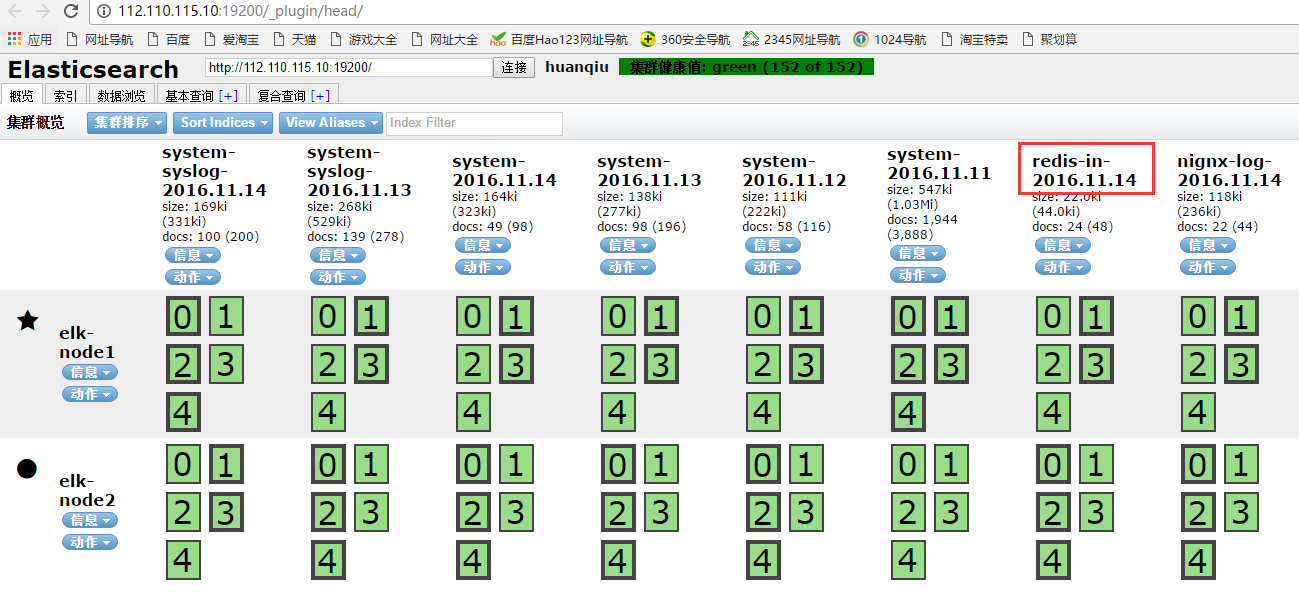

8)接着,将收集到的所有日志写入到redis中。这了重新定义一个添加redis缓存后的总文件shipper.conf。(可以将之前执行的总文件file.conf停掉)
[root@elk-node1 ~]# vim shipper.confinput { file { path => "/var/log/messages" type => "system" start_position => "beginning" } file { path => "/var/log/elasticsearch/huanqiu.log" type => "es-error" start_position => "beginning" codec => multiline { pattern => "^\[" negate => true what => "previous" } } file { path => "/var/log/nginx/access_json.log" codec => json start_position => "beginning" type => "nginx-log" } syslog { type => "system-syslog" host => "192.168.1.160" port => "514" } } output { if [type] == "system"{ redis { host => "192.168.1.160" port => "6379" db => "6" data_type => "list" key => "system" } } if [type] == "es-error"{ redis { host => "192.168.1.160" port => "6379" db => "6" data_type => "list" key => "demo" } } if [type] == "nginx-log"{ redis { host => "192.168.1.160" port => "6379" db => "6" data_type => "list" key => "nginx-log" } } if [type] == "system-syslog"{ redis { host => "192.168.1.160" port => "6379" db => "6" data_type => "list" key => "system-syslog" } }}执行上面的文件(提前将上面之前启动的file.conf文件的执行给结束掉!)
[root@elk-node1 ~]# /opt/logstash/bin/logstash -f shipper.conf --configtest
Configuration OK
[root@elk-node1 ~]# /opt/logstash/bin/logstash -f shipper.conf
Settings: Default filter workers: 1
Logstash startup completed
在redis中查看:
[root@elk-node1 ~]# redis-cli -h 192.168.1.160
192.168.1.160:6379> info
# Server
redis_version:2.8.19
.......
.......
# Keyspace
db6:keys=1,expires=0,avg_ttl=0 #显示是db6
192.168.1.160:6379> select 6
OK
192.168.1.160:6379[6]> keys *
1) "demo"
2) "system"
192.168.1.160:6379[6]> keys *
1) "nginx-log"
2) "demo"
3) "system"
另开一个窗口,添加点日志:
[root@elk-node1 ~]# logger "12325423"
[root@elk-node1 ~]# logger "12325423"
[root@elk-node1 ~]# logger "12325423"
[root@elk-node1 ~]# logger "12325423"
[root@elk-node1 ~]# logger "12325423"
[root@elk-node1 ~]# logger "12325423"
又会增加日志:
192.168.1.160:6379[6]> keys *
1) "system-syslog"
2) "nginx-log"
3) "demo"
4) "system"
其实可以在任意的一台ES中将数据从redis读取到ES中。
下面咱们在elk-node2节点,将数据从redis读取到ES中:
编写文件:
[root@elk-node2 ~]# cat file.confinput { redis { type => "system" host => "192.168.1.160" port => "6379" db => "6" data_type => "list" key => "system" } redis { type => "es-error" host => "192.168.1.160" port => "6379" db => "6" data_type => "list" key => "es-error" } redis { type => "nginx-log" host => "192.168.1.160" port => "6379" db => "6" data_type => "list" key => "nginx-log" } redis { type => "system-syslog" host => "192.168.1.160" port => "6379" db => "6" data_type => "list" key => "system-syslog" } }output { if [type] == "system"{ elasticsearch { hosts => ["192.168.1.160:9200"] index => "system-%{+YYYY.MM.dd}" } } if [type] == "es-error"{ elasticsearch { hosts => ["192.168.1.160:9200"] index => "es-error-%{+YYYY.MM.dd}" } } if [type] == "nginx-log"{ elasticsearch { hosts => ["192.168.1.160:9200"] index => "nignx-log-%{+YYYY.MM.dd}" } } if [type] == "system-syslog"{ elasticsearch { hosts => ["192.168.1.160:9200"] index => "system-syslog-%{+YYYY.MM.dd}" } }}执行:
[root@elk-node2 ~]# /opt/logstash/bin/logstash -f file.conf --configtest
Configuration OK
[root@elk-node2 ~]# /opt/logstash/bin/logstash -f file.conf &
去redis中检查,发现数据已经被读出到elasticsearch中了。
192.168.1.160:6379[6]> keys *
(empty list or set)
同时登陆logstash和kibana看,发现可以正常收集到日志了。
可以执行这个 去查看nginx日志
[root@elk-node1 ~]# ab -n10000 -c1 http://192.168.1.160/
也可以启动多个redis写到ES中,具体根据自己的实际情况而定。
- ELK实时日志分析平台环境部署
- ELK实时日志分析平台环境部署
- ELK实时日志分析平台环境部署
- ELK实时日志分析平台环境部署--完整记录
- ELK实时日志分析平台环境部署--完整记录
- ELK实时日志分析平台环境部署--完整记录
- ELK实时日志分析平台
- 开源实时日志分析ELK平台部署
- 开源实时日志分析ELK平台部署
- ELK 开源实时日志分析平台部署安装
- 开源实时日志分析ELK平台部署
- 开源实时日志分析ELK平台部署
- 开源实时日志分析ELK平台部署
- 开源实时日志分析ELK平台部署
- 日志实时分析平台ELK部署(+shield安全组件)
- elk实时日志分析平台部署搭建详细实现过程
- 开源实时日志分析ELK平台部署
- 开源实时日志分析ELK平台部署
- hdu1078
- 循环优化
- NOIP2016 Day2T2蚯蚓 题解报告
- 求1+2+3+...+n,要求不能使用乘除法、for、while、if、else、switch、case等关键字及条件判断语句(A?B:C)
- [Linux] shell脚本之if判断
- ELK实时日志分析平台环境部署
- html javasript 创建类
- JS 学习笔记1
- EasyUI之动态修改或添加textbox等表单组件
- 微信获取地理位置
- python使用豆瓣源安装库/插件
- storyboard中 tableView的cell禁止响应的方式与label换行
- JavaScript 操作HTML DOM元素
- [Python]获取类的成员变量及临时变量


